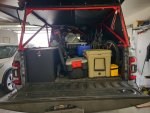We have a 2008 Silverado 1500, non-lifted with Helwig helpers and Bilsteins. It carries a FWC Raven shell with dual propane tanks and a heater. The GVWR is 7000. GAWR Front and Rear are 3950. With a full tank of gas an extra 5 gallon can, a few things we never pull, including compressor and safety gear plus both of us, we’re at 3400 front and 3600 rear, for 7000 total…unloaded.
Depending on where we go, we bring various things. In the winter we carry front and rear chains. If we’re going to Hart, The Steens or Death Valley, we bring an extra spare. We occasionally carry 2 E-Bikes. Of course we bring food, water, etc.
Because it’s a shell and we’re the second owners, I just assumed we’d be at or below spec when loaded. We’ve used it that way for over a year. It drives fine both on road and even semi-technical off road. We load the bulk of our gear in the back seat of the crew cab, so the load is balanced. I only weighed it because I was thinking about replacing the bed with a deck for more storage (not gonna happen now!)
I know every Tacoma with a FWC is overweight, probably by a lot. I’m just wondering how concerned we should be and if there’s anything more we can/should do to mitigate the situation.
Thanks in advance for the advice.
Bringing this back on topic for the OP...
The only way you can legally increase your payload is to remove weight from the vehicle itself. Do you use the back seat for passengers? You wrote that you load the bulk of your gear in the back seat. If you don't use the back seat for passengers, then you can remove the seat itself to pull some dead weight out of the truck. When it is time to replace your tires, there are multiple load range E options that weigh 50 lbs or less, saving you 40-50 lbs in tire weight. If there's
anything in the truck or camper that you never use, remove it (unless it's safety gear). I don't know if you carry jumper cables, but good ones are pretty heavy. A quality booster pack, such as those from NoCo are smaller, lighter, and permit self sufficiency because no other vehicle is necessary to jump start your truck. Once the truck is running, the pack can be recharged from a 12V outlet.
Watch your axle weights and pay close attention to your tires to ensure you catch any issues before they become problems. Use your loaded axle weights and a load/inflation table to ensure that you are running proper inflation pressures for the load you are carrying.
The GVWR issue is only contentious because so many people want to do what they want to do, with the vehicle they want to do it with, and enforcement is lax when it comes to personal/recreational/non-commercial vehicles, especially in the USA. Helper springs, or entirely new spring packs, cannot increase the payload of your vehicle, but they can improve the ability to support the payload (less sag & sway), which has benefits when operating near the limit.
Enjoy your truck, it's a good looking rig! You're asking the right questions and appear to be acting prudently considering your truck and load. Sorry that your thread went so far off the rails...that usually happens around page 2.



